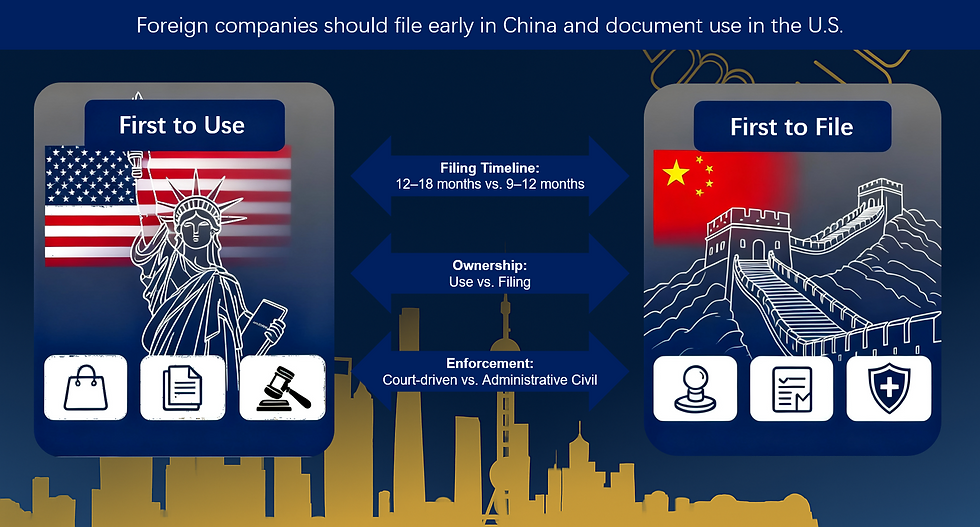China vs. U.S. Trademark Law: Key Differences for International Businesses
- GOMAXGROUP

- Sep 14
- 4 min read
Updated: Sep 17
For companies expanding internationally, trademark protection is more than just a legal formality—it is an essential safeguard for brand value and market presence. Both China and the United States operate robust trademark systems, but they are built on very different legal philosophies. These differences directly affect how rights are acquired, how applications are handled, and how enforcement works in practice.
As a trademark agency working with international clients more than ten years, we regularly guide businesses through the contrasts between the Chinese and U.S. systems. This article provides a practical, client-focused comparison of the two frameworks, so that brand owners can make informed decisions and avoid common pitfalls.

1. Trademark Ownership: First-to-File vs. First-to-Use
China: First-to-File System
In China, trademark rights are granted to the first party that files the application with the China National Intellectual Property Administration (CNIPA). Actual use of the trademark in commerce is not required for registration. This makes early filing essential, as many foreign companies have faced the problem of “trademark squatting,” where a local party registers the brand before the rightful owner enters the market.
United States: First-to-Use Principle
The U.S., managed by the United States Patent and Trademark Office (USPTO), grants rights to the party that first uses the trademark in commerce, even before registration. While registration strengthens rights, priority is based on use. This system can protect businesses with genuine market activity even if they filed later.
Key Difference: In China, timing of filing is everything. In the U.S., evidence of use plays a decisive role.
2. Filing Procedures and Requirements
China (CNIPA)
Foreign companies must appoint a local trademark agent or law firm; direct filing is not allowed.
Applications require the mark, list of goods/services, and applicant details.
Multi-class applications are possible but uncommon; typically, separate applications are filed for each class.
No evidence of prior use is needed at the application stage.
United States (USPTO)
Foreign applicants must be represented by a U.S.-licensed attorney.
Two main filing bases: “use in commerce” (Section 1(a)) and “intent-to-use” (Section 1(b)).
Evidence of use, such as labels or packaging, must eventually be provided.
Multi-class applications are permitted within one filing.
3. Timeline and Costs
China
Examination: 6–9 months.
Publication for opposition: 3 months.
Registration: total 9–12 months if no objections.
Costs are relatively low, but translation and agency fees add to expenses.
United States
Examination: 8–12 months.
Publication for opposition: 30 days.
Registration: 12–18 months, longer if “intent-to-use” is filed.
Costs are higher due to attorney fees and evidence requirements.
4. Maintenance and Renewal
China
Valid for 10 years, renewable indefinitely.
Vulnerable to cancellation if unused for three consecutive years.
United States
Valid for 10 years, renewable indefinitely.
Affidavit of continued use must be filed between years 5–6.
Vulnerable to cancellation if unused for three years, but good faith intent to resume use may protect the registration.
5. Enforcement and Remedies
China
Administrative actions through local market regulators or CNIPA.
Civil lawsuits in People’s Courts.
Criminal liability for serious infringement.
Damages are improving but often lower than U.S. awards.
United States
Enforcement mainly through federal courts.
Statutory damages, injunctions, and recovery of profits.
Stronger damages and deterrent effect compared to China.

6. Practical Advice for Foreign Businesses
File Early in China – Given the first-to-file rule, foreign companies should register trademarks as soon as possible, even before entering the Chinese market.
Register Both English and Chinese Names – Many foreign brands are known by a Chinese translation or transliteration. Protect both versions to prevent third parties from registering them.
Consider the Madrid Protocol – Both China and the U.S. are members. Using the Madrid System may simplify filings, but local expertise is still essential.
Budget for Renewals and Enforcement – Long-term strategy is crucial. Factor in renewal fees, monitoring services, and enforcement costs.
Work with Local Counsel – Foreign applicants are required to hire local attorneys in both jurisdictions. Choose experienced counsel to avoid mistakes.
7. Frequently Asked Questions (FAQ)
1. Can foreign companies register trademarks directly in China?
No. Foreign companies cannot file trademarks directly with CNIPA. They must appoint a licensed Chinese trademark agency or attorney.
2. Do I need a Chinese company to apply for a trademark in China?
No. Foreign businesses or individuals can apply as trademark owners. However, representation by a Chinese trademark attorney is mandatory.
3. Should I register both my English brand name and Chinese brand name?
Yes. Registering both is strongly recommended. If you do not register a Chinese equivalent, others may do so, leading to disputes and consumer confusion.
4. How long does it take for a foreign applicant to get a trademark in China?
On average, 9–12 months. The timeline is the same for foreign and domestic applicants, but communication through your Chinese attorney is required.
5. Can foreign companies use the Madrid Protocol to file trademarks in China?
Yes. If your country is a Madrid Protocol member, you can designate China in your application. However, CNIPA will still conduct a substantive examination, and having local legal support is recommended.
Conclusion
The trademark systems of China and the United States reflect different legal traditions. China emphasizes early registration and administrative efficiency, while the U.S. emphasizes actual commercial use and provides powerful but complex enforcement tools.
For businesses active in both markets, understanding these contrasts is not optional—it is essential. By filing early in China, documenting use in the U.S., and tailoring strategy to each jurisdiction, companies can protect their brands effectively and avoid costly disputes.
Working with an experienced trademark agent will ensure that your applications are filed correctly, deadlines are not missed, and enforcement strategies are ready when needed. In a global economy, proactive trademark protection is one of the best investments you can make for your brand’s long-term security. Talk to TMRegisterChina Expert and start to protect your brand today!



